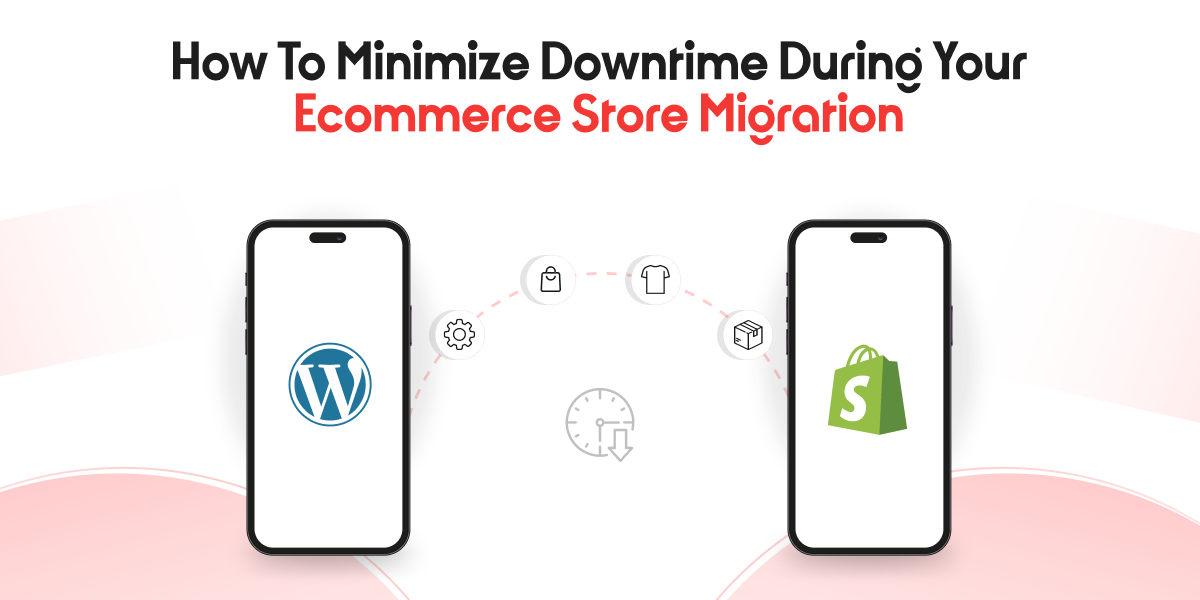How to Minimize Downtime During Your Ecommerce Store Migration

Migrating an eCommerce store to a new platform or upgraded system is a complex yet rewarding endeavor. However, the migration process can introduce risks, with potential downtime being one of the primary concerns.
Minimizing downtime is essential, as even a short period of unavailability can impact sales, customer satisfaction, and brand reputation.
To help you navigate this transition, here’s a guide on how to effectively manage and minimize downtime during your eCommerce store migration, utilizing eCommerce store migration services, and tips from Shopify expert services for migration.
Hence read the following article till the end to know more about how you can minimize downtime during your ecommerce store migration.
Why is Downtime Management Essential During Ecommerce Store Migration?
Downtime is more than a temporary inconvenience; it can lead to lost sales, diminished customer trust, and disruptions in SEO rankings.
Proper eCommerce store migration downtime management ensures a smoother transition, reducing any negative impact on business operations. For online stores with high traffic, downtime management should be a top priority to maintain a seamless shopping experience.
Pre-Migration Checklist: Preparing for a Smooth Transition
1. Conduct a Comprehensive Site Audit
Before initiating a migration, perform a detailed audit of your current site. Document key elements like product catalogs, images, customer data, SEO structures, URLs, and integration with third-party apps.
This audit serves as a blueprint, helping to ensure all essential data and functionality are transferred successfully.
2. Choose the Right Migration Services
Partnering with specialized eCommerce store migration services can make a world of difference. Professional migration services bring expertise in handling complex data transfers and minimizing risks.
Shopify expert services for migration, for instance, are well-versed in managing Shopify-to-Shopify migrations, as well as migrations from other platforms to Shopify. These services streamline the process and can significantly reduce the chances of downtime.
3. Create a Backup Plan
Make a full backup of your site before initiating migration. Many platforms provide built-in backup options, or you can utilize third-party backup services to safeguard all files and databases.
Having a complete, ready-to-restore backup is a critical safety net if you need to revert due to unforeseen issues during migration.
4. Choose the Right Timing for Migration
Timing is crucial for downtime management. Aim to conduct the migration during off-peak hours when site traffic is lower. Analyze historical traffic data to identify periods with the least activity, such as late nights or early mornings, or avoid high-traffic seasons if possible.
5. Inform Your Customers
Proactively communicate the upcoming migration with customers. Use social media, emails, and on-site banners to inform them of potential brief downtime. Transparency not only sets realistic expectations but also enhances trust in your brand.
Steps to Minimize Downtime During Migration
1. Staggered Migration Approach
Rather than migrating all data in one go, consider a staggered migration where core functionality is moved first, followed by less-critical data. This staged approach allows the most vital parts of the store to be operational quickly, reducing the time the site remains inaccessible.
2. Use a Test Environment
A test environment or staging site allows you to run migration simulations without affecting the live site. By testing each stage of the migration process, you can identify potential issues and rectify them before they impact customers.
3. Optimize DNS Configuration
Adjusting DNS settings to reduce TTL (Time to Live) before migration can help control downtime.
A shorter TTL means DNS records will update faster when pointing the domain to the new server, speeding up the switchover. Once migration is complete, remember to reset the TTL to its original value.
4. Plan for Data Synchronization
Keeping data synchronized is critical, particularly if you’re migrating customer data, orders, and product information.
Use automated synchronization tools to keep the data between the old and new stores consistent. This step prevents data loss, reduces downtime, and enables a smoother handover.
5. Thorough Post-Migration Testing
Once the migration is complete, conduct a comprehensive post-migration test. Verify that all product pages, categories, customer accounts, and checkout functionalities are working correctly.
Testing helps detect broken links, page errors, and any data discrepancies before the site goes fully live.
Benefits of Shopify Expert Services for Migration
For Shopify store owners or those transitioning to Shopify, Shopify expert services for migration provide tailored support, from initial site audit to final testing.
These experts are skilled in navigating Shopify’s specific settings, optimizing site speed, and ensuring SEO preservation, all while managing downtime. Shopify migration experts are particularly useful for businesses that rely heavily on platform-specific apps and integrations.
Post-Migration Strategies for Reducing Downtime Effects
1. Monitor Performance in Real Time
Tools like Google Analytics, Pingdom, and Shopify analytics can provide real-time data on user behavior and site performance. Monitoring helps detect issues quickly, enabling prompt response to prevent small problems from escalating.
2. SEO Preservation
Migration can impact SEO if URLs, metadata, and internal links are not maintained. Set up 301 redirects from the old URLs to the new URLs, and re-submit sitemaps to Google Search Console to maintain your search engine rankings.
3. Collect Customer Feedback
Post-migration, encourage customers to report any issues they encounter. A feedback loop allows you to quickly address potential glitches or missing functionality, helping refine the store’s user experience.
Conclusion
Migrating an eCommerce store requires careful planning and expert handling to minimize downtime and ensure a smooth transition.
With the help of eCommerce store migration services and Shopify expert services for migration, businesses can reduce risks, maintain SEO value, and provide a seamless customer experience.
Through thorough planning, real-time monitoring, and customer transparency, you can make the migration process efficient and downtime minimal, allowing your business to reach new heights with an improved, upgraded store.

